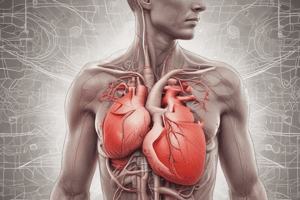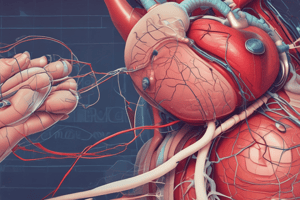Podcast
Questions and Answers
Which of the following best describes the physiological mechanism behind the S3 heart sound?
Which of the following best describes the physiological mechanism behind the S3 heart sound?
- Stiffened or stenotic valve impeding blood flow from the left atrium to the left ventricle.
- Closure of the mitral and tricuspid valves during ventricular systole.
- Turbulent blood flow due to rapid atrial contraction into a stiff ventricle.
- Rapid ventricular filling during early diastole in a dilated ventricle. (correct)
When auscultating a patient, you identify a murmur that increases in intensity during inspiration. Which side of the heart is most likely the origin of this murmur?
When auscultating a patient, you identify a murmur that increases in intensity during inspiration. Which side of the heart is most likely the origin of this murmur?
- The aorta, as inspiration increases systemic blood pressure.
- Right side, due to increased venous return to the right atrium. (correct)
- Left side, due to increased venous return to the left atrium.
- Either side, as inspiration affects both sides equally.
A patient has a murmur that is loudest at the left upper sternal border (LUSB). Which valve is most likely involved?
A patient has a murmur that is loudest at the left upper sternal border (LUSB). Which valve is most likely involved?
- Aortic valve
- Tricuspid valve
- Pulmonary valve (correct)
- Mitral valve
Which maneuver would be most helpful in differentiating between aortic stenosis and mitral regurgitation?
Which maneuver would be most helpful in differentiating between aortic stenosis and mitral regurgitation?
An echocardiogram reveals left atrial enlargement in a patient. Which auscultation finding is most likely associated with this condition?
An echocardiogram reveals left atrial enlargement in a patient. Which auscultation finding is most likely associated with this condition?
A patient is diagnosed with aortic regurgitation. Where is the murmur associated with this condition best auscultated?
A patient is diagnosed with aortic regurgitation. Where is the murmur associated with this condition best auscultated?
Which of the following actions would decrease the intensity of an aortic stenosis murmur?
Which of the following actions would decrease the intensity of an aortic stenosis murmur?
Dilation of the left ventricle is most closely associated with which heart sound?
Dilation of the left ventricle is most closely associated with which heart sound?
A patient presents with a systolic murmur that radiates to the carotid arteries. Which valvular abnormality is highest on the differential?
A patient presents with a systolic murmur that radiates to the carotid arteries. Which valvular abnormality is highest on the differential?
Inspiration has what effect on venous return and the intensity of murmurs originating on the right side of the heart?
Inspiration has what effect on venous return and the intensity of murmurs originating on the right side of the heart?
Which of the following best describes the murmur associated with mitral regurgitation?
Which of the following best describes the murmur associated with mitral regurgitation?
Which of the following conditions is LEAST likely to be associated with an S4 heart sound?
Which of the following conditions is LEAST likely to be associated with an S4 heart sound?
What causes the splitting of S2 during inspiration?
What causes the splitting of S2 during inspiration?
Which of the following interventions is expected to augment the intensity of a mitral stenosis murmur?
Which of the following interventions is expected to augment the intensity of a mitral stenosis murmur?
A patient presents with a continuous murmur. Which of the following congenital heart defects is most likely the cause?
A patient presents with a continuous murmur. Which of the following congenital heart defects is most likely the cause?
A patient is found to have a split S2 that does not vary with respiration. This finding is most consistent with which condition?
A patient is found to have a split S2 that does not vary with respiration. This finding is most consistent with which condition?
Which of the following best characterizes a functional (benign) murmur?
Which of the following best characterizes a functional (benign) murmur?
Aortic regurgitation is characterized by blood flowing backwards through the aortic valve during which phase?
Aortic regurgitation is characterized by blood flowing backwards through the aortic valve during which phase?
In paradoxical splitting, when does the P2 sound occur relative to the A2 sound?
In paradoxical splitting, when does the P2 sound occur relative to the A2 sound?
Ortner's syndrome, associated with mitral stenosis, is caused by left atrial enlargement compressing what structures?
Ortner's syndrome, associated with mitral stenosis, is caused by left atrial enlargement compressing what structures?
Flashcards
What is S1?
What is S1?
Closure of the mitral and tricuspid valves; best heard at the mitral listening area.
What is S2?
What is S2?
Closure of the aortic and pulmonary valves; A2 closes before P2 normally.
What is S3?
What is S3?
Rapid ventricular filling during early diastole in LV dilation.
What is S4?
What is S4?
Signup and view all the flashcards
How does inspiration affect murmurs?
How does inspiration affect murmurs?
Signup and view all the flashcards
How does expiration affect murmurs?
How does expiration affect murmurs?
Signup and view all the flashcards
What is squatting's effect on murmurs?
What is squatting's effect on murmurs?
Signup and view all the flashcards
What is standing's effect on most murmurs?
What is standing's effect on most murmurs?
Signup and view all the flashcards
What is the effect of hand grips on murmurs?
What is the effect of hand grips on murmurs?
Signup and view all the flashcards
What qualities are used to describe murmurs?
What qualities are used to describe murmurs?
Signup and view all the flashcards
What is a systolic murmur?
What is a systolic murmur?
Signup and view all the flashcards
What is a diastolic murmur?
What is a diastolic murmur?
Signup and view all the flashcards
What is a functional murmur?
What is a functional murmur?
Signup and view all the flashcards
What is aortic stenosis?
What is aortic stenosis?
Signup and view all the flashcards
What is aortic regurgitation?
What is aortic regurgitation?
Signup and view all the flashcards
What is mitral regurgitation?
What is mitral regurgitation?
Signup and view all the flashcards
What is mitral stenosis?
What is mitral stenosis?
Signup and view all the flashcards
Describe physiologic splitting
Describe physiologic splitting
Signup and view all the flashcards
Fixed splitting
Fixed splitting
Signup and view all the flashcards
Paradoxical splitting
Paradoxical splitting
Signup and view all the flashcards
Study Notes
Normal Auscultation Findings: S1
- Closure of the mitral and tricuspid valves during the cardiac cycle produces the S1 sound.
- The S1 sound is best auscultated at the mitral listening area on the chest.
Normal Auscultation Findings: S2
- S2 corresponds to the closure of the aortic and pulmonic valves.
- A2 is the aortic valve closing and typically occurs first due to higher pressure.
- P2 is the pulmonic valve closing.
- The S2 sound is best heard at the left upper sternal border.
Normal Auscultation Findings: S3
- S3, also known as a "Gallop," occurs during early diastole.
- Rapid ventricular filling in a dilated left ventricle causes blood to bounce off the walls.
- The phenomenon then creates turbulence and a murmur.
- This sound is best heard at the apex of the heart when the patient is lying on their left side.
- S3 can be normal in young athletes, or associated with systolic heart failure, dilated cardiomyopathy, and dilated ventricles.
Normal Auscultation Findings: S4
- S4, referred to as "Atrial kick," occurs in late diastole while blood enters into a stiff left ventricle.
- The atrium has to contract harder due to the increased pressure to facilitate ventricular filling.
- S4 is associated with diastolic heart failure, left ventricular hypertrophy (LVH), aortic stenosis, and chronic hypertension.
Bedside Maneuvers and Murmur Changes
- Various bedside maneuvers such as inspiration, hand grip, Valsalva, and squatting aid in diagnosing valvular disease by altering murmurs.
- A basic understanding of echocardiographic representation of cardiac events helps to identify valvular lesions.
Systolic vs. Diastolic Murmurs
- Murmurs vary in timing, intensity, location, and frequency
- Systolic murmurs occur between S1 and S2
- They can be crescendo-decrescendo or holosystolic murmurs
- Diastolic murmurs occur between S2 and S1, after S2
- These murmurs are typically decrescendo in nature
- Continuous murmurs are associated with patent ductus arteriosus (PDA)
Functional (Benign) Murmurs
- Functional murmurs are soft, systolic, short, and symptomless.
- Special tests reveal it, and S1/S2 sounds are normal on auscultation while standing or sitting.
Aortic Stenosis
- Aortic stenosis is a systolic murmur due to narrowed, stiffened aortic valve impeding blood flow from the left ventricle.
- A crescendo-decrescendo ejection murmur and a click are characteristic.
- It is loudest at the right upper sternal border (RUSB).
- Aortic stenosis is common in older individuals with early calcifications.
- The murmur can radiate to the carotid arteries.
Aortic Regurgitation
- Aortic regurgitation is a diastolic murmur where blood flows backward through the aortic valve during early diastole.
- It presents as a long, high-pitched, "blowing" decrescendo murmur.
- The murmur is best heard around Erb's point, and severe cases may cause bobbing of the head.
Mitral Regurgitation
- Mitral regurgitation is a systolic murmur.
- It presents as a holosystolic, high-pitched "blowing" murmur occurring between S1 and S2.
- Carvallo’s sign helps to differentiate between tricuspid and mitral regurgitation.
- Mitral regurgitation is loudest at the cardiac apex, can radiate to the axilla, and is common after myocardial infarction (MI).
- Tricuspid regurgitation is loudest at the lower left sternal border (LLSB) and commonly caused by right ventricular dilation.
Mitral Stenosis
- Mitral stenosis presents as a diastolic murmur.
- The valve becomes stiffened or stenotic thus impeding blood flow from the left atrium (LA) to the left ventricle (LV).
- An opening "snap" is auscultated after the S2 sound.
- The murmur is heard at the apex of the heart and can radiate to the axilla.
- It presents as a rumbling mid-to-late diastolic decrescendo murmur.
- Ortner syndrome can occur, where LA enlargement leads to compression of the esophagus and laryngeal nerve causing dysphagia and hoarseness.
Physiological Splitting of S2
- S1 precedes S2: A2 then P2 during expiration
- During inspiration, intrathoracic pressure decreases, which increases filling time in RA and RV
- There is an ↑ in venous return/ SV of RV, delaying closure of the pulmonic valve, with the P2 sound coming later due to the delay
Wide Splitting
- This is when A2/P2 can be differentiated because the right side of the heart isn't working properly
- During expiration, the A2/P2 split is slight
- During inspiration, the A2/P2 split is much more pronounced
- Conditions that delay emptying the RV due to the increase in the overload: RBBB, pulmonic stenosis, RV not contracting well, or pulmonary HTN
Fixed Splitting
- Fixed splitting involves a right venous return
- There is the same split between A2 and P2 during both expiration and inspiration
- Common in atrial septal defect
Paradoxical Splitting
- P2 precedes A2.
- It is wider during expiration because more blood flow is coming to the left side of the heart.
- Less wide during inspiration because more blood flow is coming to the right side of the heart.
- Common when there is a delayed closure of the aortic valve due to delay in left ventricular expulsion.
- Associated with aortic stenosis, LBBB, hypertrophic cardiomyopathy, and hypertension because anything that causes the afterload to be high.
Studying That Suits You
Use AI to generate personalized quizzes and flashcards to suit your learning preferences.




